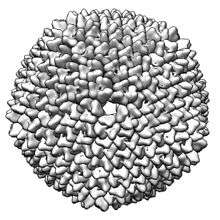Tectivirus
Tectiviridae is a family of viruses with seven species in three genera. Bacteria serve as natural hosts.[2][3] Tectiviruses have no head-tail structure, but are capable of producing tail-like tubes of ~ 60×10 nm upon adsorption or after chloroform treatment. The name is derived from Latin tectus (meaning 'covered').
| Tectiviridae | |
|---|---|
 | |
| CryoEM model of Enterobacteria phage PRD1 capsid. PDB entry 1gw7[1] | |
| Virus classification | |
| (unranked): | Virus |
| Realm: | Varidnaviria |
| Kingdom: | Bamfordvirae |
| Phylum: | Preplasmiviricota |
| Class: | Tectiliviricetes |
| Order: | Kalamavirales |
| Family: | Tectiviridae |
| Type species | |
| Enterobacteria phage PRD1 | |
| Genera | |
|
Alpatectivirus | |
Virology
The virions of Tectiviridae species are non-enveloped, icosahedral and display a pseudo T=25 symmetry.[2] The capsid has two layers. The outer layer is a protein structure of 240 capsid proteins trimers, and the inner one is a proteinaceous lipid membrane which envelopes the virus genome. Apical spikes extending about 20 nanometers (nm) protrude from the icosahedrons vertices.
The genome is a single molecule of linear double-stranded DNA of 15 kilobases in length, and has 30 open reading frames.[2] It forms a tightly packed coil and encodes several structural proteins. It encodes about 30 proteins that are transcribed in operons. At least 9 structural proteins are present in the viron. The genome is about 66 megaDaltons in weight and constitutes 14–15% of the virion by weight. Lipids constitute a further 15% by weight. Carbohydrates are not present.
Life cycle
Viral replication is cytoplasmic. Entry into the host cell is achieved by adsorption into the host cell.[2] After adsorption to the host cell surface the virion extrudes a tail-tube structure through a vertex for genome delivery into the host. Replication follows the DNA strand displacement model. DNA-templated transcription is the method of transcription.[2] Capsid proteins polymerize around a lipoprotein vesicle translocated in the cytoplasm by virion assembly factors.
Mature virons are released by lysis, which, in the case of PRD1, is achieved with the aid of virus-encoded lysis machinery consisting of four proteins: P15 (endolysin),[4] P35 (holin),[5] P36 and P37 (homologues of the Rz/Rz1 proteins of phage lambda).[6]
Taxonomy
Tectiviruses have been classified into three major groups: (1) phages that infect Gram-negative bacteria (which lyse the host cell, not forming prophages) (2) those that infect Gram-positive bacteria (forming prophages) and (3) a virus that infects Gluconobacter cerinus. The tectivirus groups have a similar genome size and organization, but they have no detectable sequence similarity at the nucleotide level.[7]
Three genera have been identified in this family: Alphatectivirus - infecting Enterobactericeae; Betatectivirus - infecting Gram positive bacteria; and Gammatectivirus.
Examples[3]
- Bacillus phage AP50
- Bacillus phage Bam35
- Enterobacteria phage PRD1
A fourth genus - Deltatectivirus - has been created for a number of phages (Forthebois, WheeHeim and Rhodococcus phage Toil) infecting Actinobacteria hosts.[8]
References
- San Martín, C; Huiskonen, JT; Bamford, JK; Butcher, SJ; Fuller, SD; Bamford, DH; Burnett, RM (2002). "Minor proteins, mobile arms and membrane-capsid interactions in the bacteriophage PRD1 capsid". Nature Structural Biology. 9 (10): 756–63. doi:10.1038/nsb837. PMID 12219080.
- "Viral Zone". ExPASy. Retrieved 15 June 2015.
- ICTV. "Virus Taxonomy: 2014 Release". Retrieved 15 June 2015.
- Caldentey J, Hänninen AL, Bamford DH (1994). "Gene XV of bacteriophage PRD1 encodes a lytic enzyme with muramidase activity". Eur J Biochem. 225 (1): 341–346. doi:10.1111/j.1432-1033.1994.00341.x. PMID 7925454.
- Rydman PS, Bamford DH (2003). "Identification and mutational analysis of bacteriophage PRD1 holin protein P35". J Bacteriol. 185 (13): 3795–3803. doi:10.1128/JB.185.13.3795-3803.2003. PMC 161566. PMID 12813073.
- Krupovic M, Cvirkaite-Krupovic V, Bamford DH (2008). "Identification and functional analysis of the Rz/Rz1-like accessory lysis genes in the membrane-containing bacteriophage PRD1". Mol Microbiol. 68 (2): 492–503. doi:10.1111/j.1365-2958.2008.06165.x. PMID 18366440.
- Saren, Ari-Matti; Ravantti, Janne J.; Benson, Stacy D.; Burnett, Roger M.; Paulin, Lars; Bamford, Dennis H.; Bamford, Jaana K. H. (15 July 2005). "A Snapshot of Viral Evolution from Genome Analysis of the Tectiviridae Family". Journal of Molecular Biology. 350 (3): 427–440. doi:10.1016/j.jmb.2005.04.059. PMID 15946683.
- Caruso SM, deCarvalho TN, Huynh A, Morcos G, Kuo N, Parsa S, Erill I (2019) A novel genus of Actinobacterial Tectiviridae. Viruses 11(12) | doi:10.3390/v11121134. PMID 31817897
Further reading
- ICTVdB—The Universal Virus Database ICTVdB Management (2006). 00.068. Tectiviridae. In: ICTVdB—The Universal Virus Database, version 3. Büchen-Osmond, C. (Ed), Columbia University, New York, USA
- Virus Taxonomy: Eighth Report of the International Committee on Taxonomy of Viruses H.V. Van Regenmortel, D.H.L. Bishop, M. H. Van Regenmortel, Claude M. Fauquet (Eds)
- 68.0.1. Tectivirus